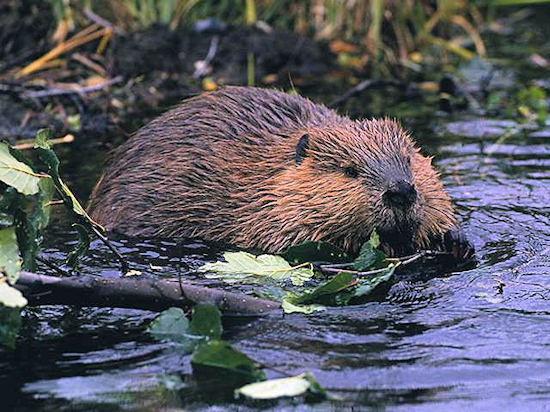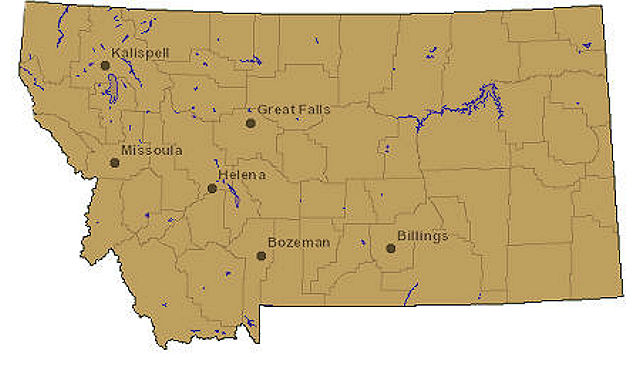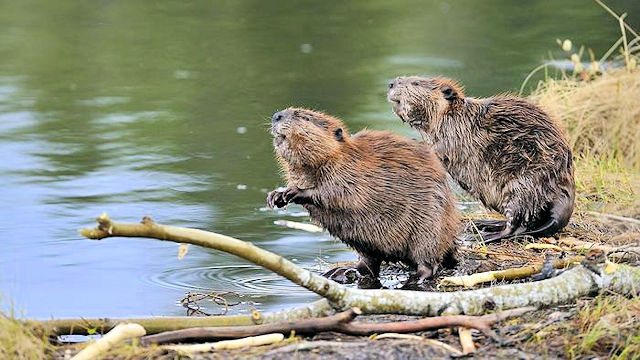Beaver

Castor canadensis
Order:
Rodentia
Family:
Castoridae
Status: An abundant, important fur animal and water conservationist. Its value as a fur animal was responsible for much of the early exploration of North America. Is one of the most intensively studied furbearers in North America. Official Montana furbearer managed and protected by regulated fur harvest seasons.
Identifying Characteristics: The largest rodent in North America north of Panama. On land is a large, clumsy, hump-backed animal. In the water, becomes sleek and torpedo-shaped. Propels itself with powerful webbed hind feet.
Beavers use their large dorsally flattened, scale-covered tail to maneuver in water. Slapping the tail on the water surface is used as a signal of alarm. Beaver also slap their tails during periods of play. Split nail on the second hind toe is used for grooming. Incisors are large and continually growing. Fur is rich brown with black to reddish guard hairs. Underfur is soft and extremely dense with excellent insulating qualities. Both sexes have a pair of anal glands and castor sacs located ventrally. Beavers emit anal gland secretions year round.
Total length: 34 to 40 inches. Weight: 30 to 60 pounds and sometimes heavier.
Habitat: Occupies a wide variety of habitats in North America. Water and associated woody vegetation are the most essential components of beaver habitat. Ideal beaver living sites include ponds, lakes, streams, and rivers.
Food Habits: Beavers are strict herbivores. Beavers eat a variety of woody and herbaceous species. Willows, mountain alder, and aspen are important foods. Will also consume herbaceous vegetation during summer. Much of the woody vegetation beavers cut is not used for food. Caches woody vegetation near shore for winter food.
Life History: Builds stick and mud dams across streams. Mostly nocturnal. May build large conical houses at the edge of a lake or burrow into the bank for a den along rivers. Beaver life is based on a family unit consisting of a pair of adults, yearlings, and kits. Breeds form January through March. 2 to 4 young are born after a 105 to 107 day gestation period. One litter per year is produced. Two-year-olds are eventually driven from or leave the parental home.
Similar Species: River otter - tail covered with fur. Muskrat - smaller, tail slender.
The beaver is the largest North American rodent. A common furbearer, the beaver inhabits waterways of every North American state and Canadian Province. A unique paddle shaped tail distinguishes the species and self-sharpening teeth allow beavers to mow down sizable trees. Beaver often alter the landscape with the construction of dams, canals and lodges. Beaver are territorial as long as the habitat will support family groups called "colonies". Beaver are powerful animals both on land and in the water.
 Description
Description
Beaver continue to grow in size throughout life, and weights in excess of 60 or 70 pounds do occur when foods are abundant and accessible during the entire year. Unlike many other species, females are as large as males of the same age, and they sometimes are larger. A paddle shaped, leathery tail, positively identifies the species. An adult's tail is usually about 10 inches long, and 5 or 6 inches wide, with a thickness of 1/2 inch in the middle.
The hind feet of beaver are fully webbed, and large. These feet often measure 6 inches in length, and the spread of the toes is equal to or greater than the length as the beaver swims. Five toes with strong nails are found on the hind feet, including unique split toenail on one toe which serves the beaver as a comb for grooming. The front feet seem small in contrast to the hind feet. These feet measure 2 1/2 to 3 inches in length and are not webbed at all. Beaver normally swim with their front feet held against their chest, and the large webbed hind feet provide the propulsion with the tail acting as a rudder.
Guard hairs in beaver fur are 2 inches in length, overlaying a soft and dense underfur about an inch deep. Colors vary from section to section, and from blonde colors to nearly black. Both male and female beaver have large glands, called castors, beneath the skin on the lower bellies. These glands produce an oil which the beaver combs into its fur to waterproof it. This oil is also deposited by the beaver at selected locations as territorial markers or mating attractants in the spring of the year.
Beaver have transparent eyelids which cover the eyes as the beaver submerges, enabling the beaver to see well when submerged as the eyeball is protected from abrasive particles suspended in the water. The ears and nose of a beaver have valves that close as a beaver submerges, preventing the entry of water. Two upper and two lower incisor teeth dominate the front of a beaver's mouth. The upper incisors overlap the lower incisors, and friction from chewing causes the teeth to self-sharpen to chisel sharpness.
Similar to birds and reptiles, beaver have a single lower body opening, known as a cloaca. This single opening serves the urinary and bowel tracts, the secreted oil from the castor glands, and covers the reproductive organs of both males and females.
 Reproduction
Reproduction
Beaver usually live in family units consisting
of the older mated pairs, young from the
previous year, and young from the current season
called kits. Breeding season takes place in late
January or February in most states. Young from
the previous year are about 22 months of age at
this time and they are evicted from the colony
to relocate and seek mates of their own. The
gestation period of beaver is 107 days and the
adult male and kits usually take up a temporary
residence in a bank den while the new litter is
being born in April, May or June. The birthing
process may take several days, and 3 to 5 kits
are a typical litter size. Beaver kits are fully
furred when born, their eyes are open, and the
incisor teeth are visable. Newborn beaver kits
take to the water easily, and they might be
swimming before they are one day old. Most adult
beaver are monogamous, and stay with their mate
throughout life.
Habits
Beaver
require deep water for protection from their
enemies, and they alter the landscape a great
deal with dam building and flooding. Dams can be
hundreds of feet in length, and vary in height
from only a few feet to 7 or 8 feet, and even
higher at times.
Permanent lodges are often constructed by piling layer after layer of sticks into a large conical form above the waterline. Two or more underwater tunnels are then chewed up into the pile, and an inner chamber hollowed out to serve as a living quarters. Finally the outside of the lodge is plastered with mud and rocks, except for the peak, which is left porous enough to allow an air exchange to the inner chamber. There are two levels to the chamber. One level is near the waterline near the "plunge holes", where the beaver shed water before climbing to the higher resting or nesting areas.
In areas prone to flooding, or where strong currents may be present, beaver usually construct bank dens by digging tunnels from underwater up into banks. Bank dens often have two or more submerged entrances. Many times the beaver will construct a pile of sticks over the tops of the underground living chambers. These piles of sticks are sometimes called "caps".
Shallow pockets are sometimes dug into banks near the waterline and these are known as "feed pockets". In northern areas, beaver construct "feed piles" by submerging large amounts of small trees and limbs to serve as a food source after ice prevents the beaver from activity above the ice. These feed piles are usually constructed close to the den as a convenience to the kit beaver, who do not normally travel far from the den itself.
At times, solitary beaver will be found living alone. These beaver are known as "bachelors", whether they are male or female.
Adult beaver mark out their territories in early spring by dragging up mud and debris from the bottom and depositing the debris in mounds along the shores, where they also deposit oil from their castor glands. These "castor mounds" often leave a reddish stain on the bank, and the odors are powerful enough for a human to easily detect.
Beaver are very territorial, and territories seldom overlap. Generations of beaver may continuously inhabit a choice area, even building canals to help float food from inland cutting sites. If and when food supplies are exhausted, they do relocate to better area. Once beaver have determined to claim a territory, they are very difficult to dissuade. If the activities of the beaver flood roads or damage property, the beaver usually have to be removed to prevent reoccurring damages.
Although beaver normally submerge for 3 or 4 minutes at a time, they are quite capable of holding their breath for 12 to 15 minutes. They exhale a little in spurts as they swim or work under water, and a large beaver is quite capable of traveling nearly 1/2 mile under the surface before it must surface for more air.
Migrations of beaver usually occur with the breaking up of ice in late winter or early spring as the 22 or 23 months old beaver are expelled just prior to birthing time for the new litter. These beaver may chose to go up or downstream. Although these beaver are capable of reproducing, they usually do not until the next season, after a mate and a new territory have been established. Most new colonies are established within a few miles of the home colony.
Beaver are primarily vegetarians although an occasional beaver may eat a dead fish. Preferred foods include the bark of aspen, willow, cottonwood, and dogwood, and many other varieties of trees and shrubs. In early spring, beaver will often eat bark and twigs of evergreens. In season, beaver will also eat water lilies, leaves, grasses, roots, and a variety of crops including corn, wheat, oats, carrots, potatoes, apples, clovers, and alfalfa.
General
Beaver
usually alter the habitat a great deal with the
building of dams, and the resulting flooding of
lowlands. The deeper water behind dams creates a
better habitat for muskrats, and a variety of
other wildlife species such as fish and
waterfowl. Mink and otter hunt regularly around
beaver dams. These locations provide suitable
denning sites as well for these furbearers.
Dam building on trout streams can have an adverse effect on trout survival by slowing the water and allowing it to warm to temperatures higher than the trout can tolerate. Dams also serve as barriers to migrating trout and salmon. At times, beaver cause significant amount of property damage by cutting trees, and flooding large areas also killing the timber. Culvert plugging is common, and often causes roads to flood and to wash out.
Beaver are also host to an internal parasite, giardiasis. Water reservoirs inhabited by beaver can and do become contaminated by the giardiasis cysts, which are too small to be filtered out of the drinking water. These cysts hatch in the small intestines of people who drink the contaminated water resulting in diarrhea, nausea, and stomach aches.
Serious beaver predators include mountain lions, wolves, lynx and bobcats. At times, a bear can and will kill mature beaver. Juvenile beaver are vulnerable to coyotes, eagles, and large owls as well. Tularemia can be a devastating disease in beaver, wiping out entire populations when conditions are good for disease transmissions. Tularemia infects livers, and is usually fatal to beaver of all ages.
A beaver is considered to be old at 12 year of age.